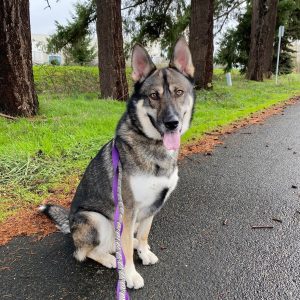Leash reactivity is one of the most common behaviors in dogs but OHS has tips and classes to help.
 Many dogs bark when they see other dogs out on a walk, out of the window or along the fence line. But, just because it’s natural behavior, it doesn’t mean you shouldn’t try to help your dog be more relaxed when seeing other dogs.
Many dogs bark when they see other dogs out on a walk, out of the window or along the fence line. But, just because it’s natural behavior, it doesn’t mean you shouldn’t try to help your dog be more relaxed when seeing other dogs.
Dogs are leash-reactive for many reasons: fear, insecurity, stress, boredom, excitement, a practiced/learned behavior, and more. Often, humans fuel the fire by accidentally rewarding undesirable behaviors, which leads to a bigger problem.
Pairing up a game of fetch, “get your toy” or a tasty food treat when your dog sees or hears another dog might seem like you are rewarding them for barking, but you are actually making a positive association between seeing a dog and something that really distracts and motivates them to do something more appropriate. In time, your dog will predict a quick game of find your toy or food with seeing a dog and the barking will reduce or stop.
Sounds easy, right?
Well, people often need help with their timing and training skills, and that’s why we are here to help with our Reactive Rover classes and private trainings either in person, or virtually.
What does the training process look like?
- Always approach training with a positive attitude, if you are feeling frustrated, stop the training and take a break.
- Choose an environment to practice where you have distance from other dogs. Distance will be key to success. Consider going for walks when it is less busy, or in quieter neighborhoods.
- Come armed with exciting treats (that he is only receiving for this practice!), a stuffed Kong, a favorite toy or all three. It never hurts to be over prepared.
- Think about exercising the dog first. Allowing the dog to play fetch or run around the yard before you practice will help burn off some steam.
- When you get the dog out to practice, reward ANY and ALL good behavior. Make sure you have a clear list in your head of acceptable behaviors; these can include looking at you, quietly looking at the other dog, sitting, moving on a loose leash, relaxed body language, etc.
- Watch your dog’s body language, so you can recognize the signs that your dog is getting overstimulated. We want to work with our dog when they are noticing the other dog, but they aren’t pulling, lunging, or are overly aroused. This distance might be further than you expect it to be.
- Increase distance when your dog is struggling. Dogs have different thresholds; learn what that distance is for your dog.
- Keep the training session short (20 minutes is sufficient), and try to always end on a good note.
Tips for success:
- Once your dog is barking and lunging at something, your best plan of action is to calmly and quickly remove him from the situation. At that moment, the emotional overload he is experiencing will prevent learning or following directions.
- Don’t worry about trying to pass another dog on the same side of the street, or getting closer to other dogs in general. It is much more important to work at a distance where your dog can be calm, to lay a solid foundation for the training.
- Consider other alternatives to physical exercise. Don’t discount mental exertion! Use puzzle toys or food dispensing toys, spend time training and teaching them new tricks, or even create your own at-home agility course to combine physical and mental stimulation. Daily enrichment is necessary for our dogs!



